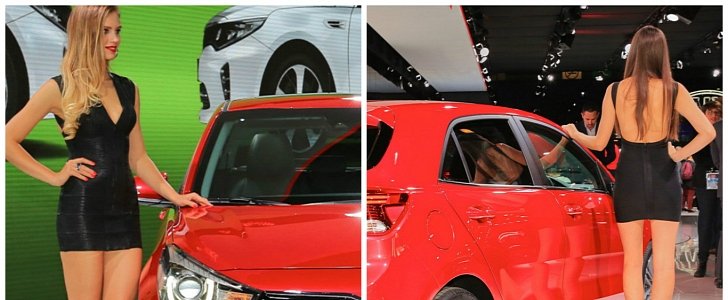Kia's little Rio has graduated from being a nasty little hatchback to the most stylish supermini present at the 2016 Paris Motor Show. We got up close and personal to see if the Koreans have something the Fiesta and Polo don't.
The overall design is a clear departure from that of the previous Rio, following the guidelines set by the popular Optima sedan and wagon. Kia's "tiger nose" grille has been made very narrow and long, but there are two variations. Regular models have honeycomb mesh, while the ultra-frugal diesel had its grille completely blocked off, like the Soul EV.
On either side of this is a sharpened set of headlights with a projector lens in the middle of a U-shaped LED lighting signature.
While the wheelbase has grown, the rear overhang has been shortened, resulting in a MINI-like stance. The new rear lights feature three arrow-shaped LED light elements, somewhat similar to what you see on the Sorento SUV. However, the trunk opening is not the largest or more accessible in its class. We think that title still goes to the Skoda Fabia. But the Rio and Fabia are almost tied for capacity (325 vs. 330 liters).
The engine range is both new and familiar at the same time. Older units like the 1.25 and 1.4-liter MPI have been kept. However, Kia has also added the 1.0-liter three-cylinder petrol turbo, which made its debut in the Cee’d.
It will be available in both 100 and 120 PS outputs, both offering 172 Nm (127 lb-ft) of torque, which is significantly more than the 132 Nm (97 lb-ft) of the 1.4L. Diesels will be the most frugal units, the best version offering 90 PS and emissions as low as 90 grams per 100 kilometers thanks in part to regenerative braking.
Besides design, the people who worked on this car had two other main tasks: handling and safety. It's said the Rio is much more engaging in the steering feel department and is guaranteed a 5-star Euro NCAP rating thanks to the Autonomous Emergency Braking system with pedestrian detection. A Lane Departure Warning System is also fitted as an option.
On either side of this is a sharpened set of headlights with a projector lens in the middle of a U-shaped LED lighting signature.
While the wheelbase has grown, the rear overhang has been shortened, resulting in a MINI-like stance. The new rear lights feature three arrow-shaped LED light elements, somewhat similar to what you see on the Sorento SUV. However, the trunk opening is not the largest or more accessible in its class. We think that title still goes to the Skoda Fabia. But the Rio and Fabia are almost tied for capacity (325 vs. 330 liters).
The engine range is both new and familiar at the same time. Older units like the 1.25 and 1.4-liter MPI have been kept. However, Kia has also added the 1.0-liter three-cylinder petrol turbo, which made its debut in the Cee’d.
It will be available in both 100 and 120 PS outputs, both offering 172 Nm (127 lb-ft) of torque, which is significantly more than the 132 Nm (97 lb-ft) of the 1.4L. Diesels will be the most frugal units, the best version offering 90 PS and emissions as low as 90 grams per 100 kilometers thanks in part to regenerative braking.
Besides design, the people who worked on this car had two other main tasks: handling and safety. It's said the Rio is much more engaging in the steering feel department and is guaranteed a 5-star Euro NCAP rating thanks to the Autonomous Emergency Braking system with pedestrian detection. A Lane Departure Warning System is also fitted as an option.



















